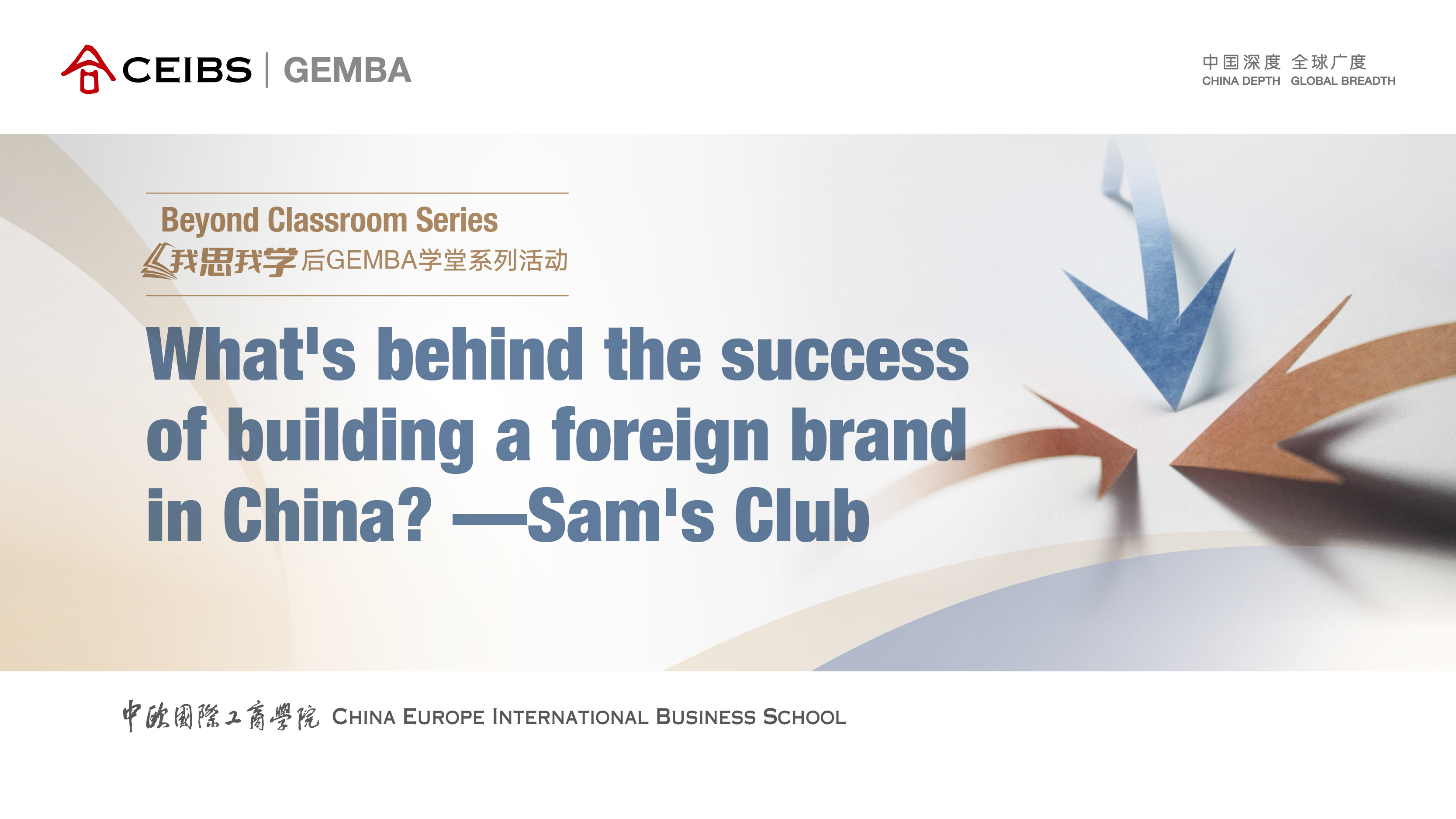How did Sam’s Club build a Successful Retail Brand in China?

On April 14th 2025, CEIBS welcomed Andrew Miles, former President of Sam’s Club China to the Shanghai Campus for the latest edition of the Beyond Classroom series. Hosted by Professor Frank Bournois, CEIBS Vice President and Dean, the event drew an audience of almost 100 CEIBS faculty, students, alumni and guests.
About Sam's Club
Founded in 1983 and operated by Walmart Inc, Sam’s Club entered the China Market in 1996. Today it operates 55 clubs and several hundred online depots across the country, making it the leading omnichannel retailer in China.
Andrew delivered the following thoughts and ideas on building brands and driving sustainable business growth during his dialogue with Professor Frank Bournois. They are drawn from his personal experiences of leading the Sam’s Club, between 2012-2025 and his earlier international experience.

Be patient, stick to your principles
There is no magic trick or silver bullet to building a successful brand in China. It takes perseverance, patience and will at times be painful.
Pain is something that businesses are less prepared to endure nowadays than in previous decades. The advent of AI, automation and advanced data analysis has convinced people and organisations around the world that, with just enough planning, you can build a strong business or build things quickly just to get a quick result. That strategy can work for the short term.
However, the reality is that experiencing pain makes a business stronger. It builds discipline and helps to refine the essence of its offering. In turn, this helps you to understand the core principles of your business model. This is often necessary to ensure you build something outstanding and differentiated that will be difficult for others to copy.
As we look to learn it’s important to benchmark with other companies. In the early days of Sam's Club China's transformation, Costco was a good example of how a business can become a market leader in the USA by staying tightly disciplined and sticking to its core principles. In its early years, it followed the ‘10/10/2’ financial model (10% gross profit, 10% cost, 2% profit from membership fees). They were highly disciplined and consistently resisted pressure from its shareholders and other stakeholders to change its business model. Instead, it retained a laser focus on providing value to its members with every product it sold. This ensured that membership had to grow for profit to grow, which also helped strengthen the loyalty of existing customers.

Sam’s Club drew inspiration from Costco, from Sam's USA and their growth journey and experiences, and other similarly focused brands when assembling its China business model. A model where customers remain at the very top of the priority list. Keep your customers' needs as your central consideration, be patient in applying your business strategy, and always remain true to your core principles, as they, when applied in a disciplined way they can separate you from your competition.
Be prepared to go against the trend
Trends can be dangerous, because we can end up chasing them without carefully considering if by doing so is appropriate or a smart move to make based on our business model.
In 2012, China was undergoing significant change in its retail space. Alibaba and Jingdong (JD) were making a rapid rise to prominence and the focus of retailers very quickly shifted towards speed and customer convenience. Similarly, digital retailing opened up options for more creative promotions and pricing strategies.
These were the signature trends of the period, but instead of embracing them without due consideration, Sam’s Club concentrated on consistency. Rather than overwhelming members with promotions and pricing structures (which can often confuse rather than delight), it focused on maintaining consistently good everyday value, underpinned by quality.
Sam's Club also reduced the number of items it was selling and focused on making every item special and outstanding. This was the approach Sam's Club took to build trust and differentiation in a time of rapid change.
This is not to say that businesses (even major brands) should simply ignore emerging trends. Analyse them, understand them, but you should only react to them if doing so will strengthen your core offering, without compromising your business principles and your business model. If this is not the case, then hold firm and avoid being sucked into a trend simply because that’s where your competitors are headed.
Purple cows, diving penguins, roaring lions
Succeeding in a retail landscape as fast paced as China forces businesses to build a range of competencies that allow them to adapt intelligently to changing market conditions. When driving change and transformation, communication is key to ensuring everyone knows the direction and "why" you are wanting to change. One approach Sam's Club adopted was to use icons to help the teams understand the behaviours and direction needed for the future model.
Purple Cow – Business author Seth Godin.
The principle encourages you to put “Purple Cow" thinking into everything you build, and everything you do. After seeing one, two or ten normal cows, seeing any more of them becomes boring. Seeing a purple cow, however, would be something remarkable. You would stop the car, take pictures and tell everyone. Your business needs to be remarkable because you want your customers to talk animatedly about it to their friends. Remember, their recommendation is more powerful than any marketing communication executed by your brand.

Diving Penguin - It’s okay to be brave and take the plunge on something new without waiting for a comprehensive analysis.
Rather than waiting 6-12 months for the results of a study, test your idea on a small scale. Then, whether it is a stunning success or failure, you will learn from it and move on quickly. Ignore the IWWIC (It Won’t Work in China) naysayers; Get out there and find out for yourself.
Roaring Lion – Remain lean, mean and agile.
Lions are powerful, but they are also highly efficient hunters. Always remember where your core strengths lie, and do everything to support them. If a specific innovation or new practice doesn’t fit the principles that made you strong in the first place, don’t hang on to it.
Too much data can be dangerous
While this may be a contentious statement to some, Andrew's experience supports the idea that an over reliance on your data can be as unhelpful as completely ignoring it.
For decades, we have been told that capturing, analysing and leveraging data effectively is what separates future-ready businesses from doomed enterprises. While there is undeniable value in data interpretation (especially when addressing China’s large, digitally literate consumer population), you must not become so dependent on data that it compromises your ability to go against the trend, against the market, and, on occasions, against what the consumer is telling you.

This relates back to the overarching point about sticking to your principles. Data is invaluable for giving you a much more informed understanding of your customers’ opinions and experiences regarding your brand. This can lead to much-needed changes, but there are times when rushing to act on data-based insights may draw you away from the very things that made you attractive to your audience in the first place.
Retail is an art, as well as a science. Over reliance on data will leave you too little room for the kind of unconventional thinking that elevates the best brands to the top of their game.
The most underrated business strategy
China’s retail market rewards decisiveness, and punishes confusion. Too many businesses enter it without anchoring themselves to a clear identity; they let external forces – trends, competitors, new CEOs – dictate their moves. If you don’t know who you are, you will be pulled in every direction. So, define your model, have a precise vision, believe in it, and adapt when necessary.
Be ready to over communicate to your teams so everyone can be part of the change and remember to tell them why. Why is it important we do this and why is your role key to our future success.
Keep it simple - Easy to say, difficult to do.
Simple businesses are easier to manage, scale, and sustain.
Conversely, complexity driven by a constant flow of innovative ideas is seductive, but if not managed well, can be unhelpful and costly. Leaders love to create new formats, new distribution channels, new marketing layers, add layers of controls and processes – and by doing so add layers of unnecessary cost. Our cost structures balloon, profit margins shrink and the burden usually falls on employees and customers.
If you can develop a clear vision, build a business model defined by strong principles and maintain the discipline needed to see it through, then you will be more likely to achieve an identifiable brand that your customers can trust and tell others about. So be remarkable in everything you do. If you forget your principles or lose sight of them, it’s extremely easy to be swept away in the vastness of the China market and be lost in the crowd.

Beyond the Classroom is an ongoing series developed by the Global EMBA programme at CEIBS. It welcomes C-suite executives from the world’s most prominent organisations to share their experiences with CEIBS students and alumni. Look out for the next event if you want to learn from unique perspectives shared by the most innovative leaders in the global business community.
















